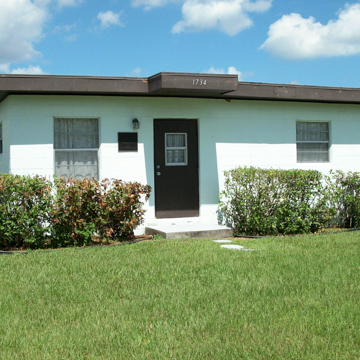Located on a modest suburban street in Fort Pierce, across from the Lincoln Park Academy, the Zora Neale Hurston House reveals several intertwined stories through its direct and uncomplicated architecture, its location, and its history.
The house was constructed in 1957 at 1734 School Court, a site due south of its current location. It belonged to a community of rental properties (single-family and duplexes) developed and owned by C. C. Benton, an African American physician, and surrounding the new location of Lincoln Park Academy, which had been founded in 1923 as Fort Pierce’s African American high school. Built from funds acquired from the sale of the property to the Fort Pierce School Board, the School Court residences were progressive forms of affordable housing that built upon those aspects of the earlier New Deal housing projects that understood housing to be both shelter and an opportunity to build community.
Typical of the other single-family houses constructed on the north side of school, the Zora Neale Hurston House was originally green with white trim and brown doors. It sported a flat roof marked by a heavy roofline that protruded forward just above the front door. The front of the house had a single living area with two small bedrooms, a kitchen, and bath at the rear, each of which had jalousie windows. Built of masonry block units, the structure was typical of many others built across Florida after World War II to house the vast new populations of working-class people moving to the state.
The developer, Benton, was a family friend of Zora Neale Hurston, the influential author known for the breadth of her knowledge of folklore and anthropology, and her extensive literary output of novels and other writings. Despite her honorary doctorates, national recognition, and friendships with many other writers, including the famed Marjorie Kinnan Rawlings not far away in Cross Creek, Hurston suffered from financial hardship and landed a job writing for the Fort Pierce Chronicle. When Benton invited Hurston to be the first tenant of the new house rent-free for the rest of her life, it was obviously a huge benefit to both parties. Hurston formed part of the academic community around the school and occasionally taught English as she struggled to find a publisher for her last work, a history of Herod the Great. She lived in the house for less than two years, before moving into the St. Lucie County Welfare, where she died from a stroke in early 1960.
As anyone who has read Hurston knows, her writing is remarkable for the originality of mind, construction of character, and sense of place. That the lyrical title phrase of her most famous work, Their Eyes Were Watching God (1937), refers to a group of people experiencing a Florida hurricane from within a heaving structure is perhaps evidence enough. It was, however, an enormous achievement to have the modest Hurston House registered through the National Park Service as a National Historic Landmark in 1991. As a structure built for the working poor, the architecture lacked the usual exceptional physical features of landmark buildings. In addition, up to that point there had been traditionally less interest in architectural history as related to women or African Americans, and there was only the beginning of a revival of interest in Hurston’s work. Considering these factors, this house stands as a tribute to those who pioneered the Woman’s Landmark Project (begun in the mid-1980s) and who can count the Zora Neale Hurston House as one of their many great success stories in architectural history.
In 1995, to allow for expansion of the Lincoln Park Academy, the house was moved to its current location. It is now a stop on the Zora Neale Hurston Dust Tracks Heritage Trail, dedicated in 2004, which documents Hurston’s travels in Florida and the Caribbean.
References
Grossman, Elizabeth. “A Historic Site of One’s Own.” The Women’s Review of Books 10, no. 9 (June 1993): 13-14.
Miller, Page Putnam, “Zora Neale Hurston House,” St. Lucie County, Florida. National Historic Landmark Nomination Form, 1991. National Park Service, U.S. Department of the Interior, Washington, D.C.
Miller, Page Putnam. “Reflections on Federal Policy and Its Impact on Understanding Women’s Past at Historic Sites.” In Restoring Women’s History through Historic Preservation, edited by Gail Lee Dubrow and Jennifer B. Goodman. Baltimore, MD: Johns Hopkins University Press, 2003.

